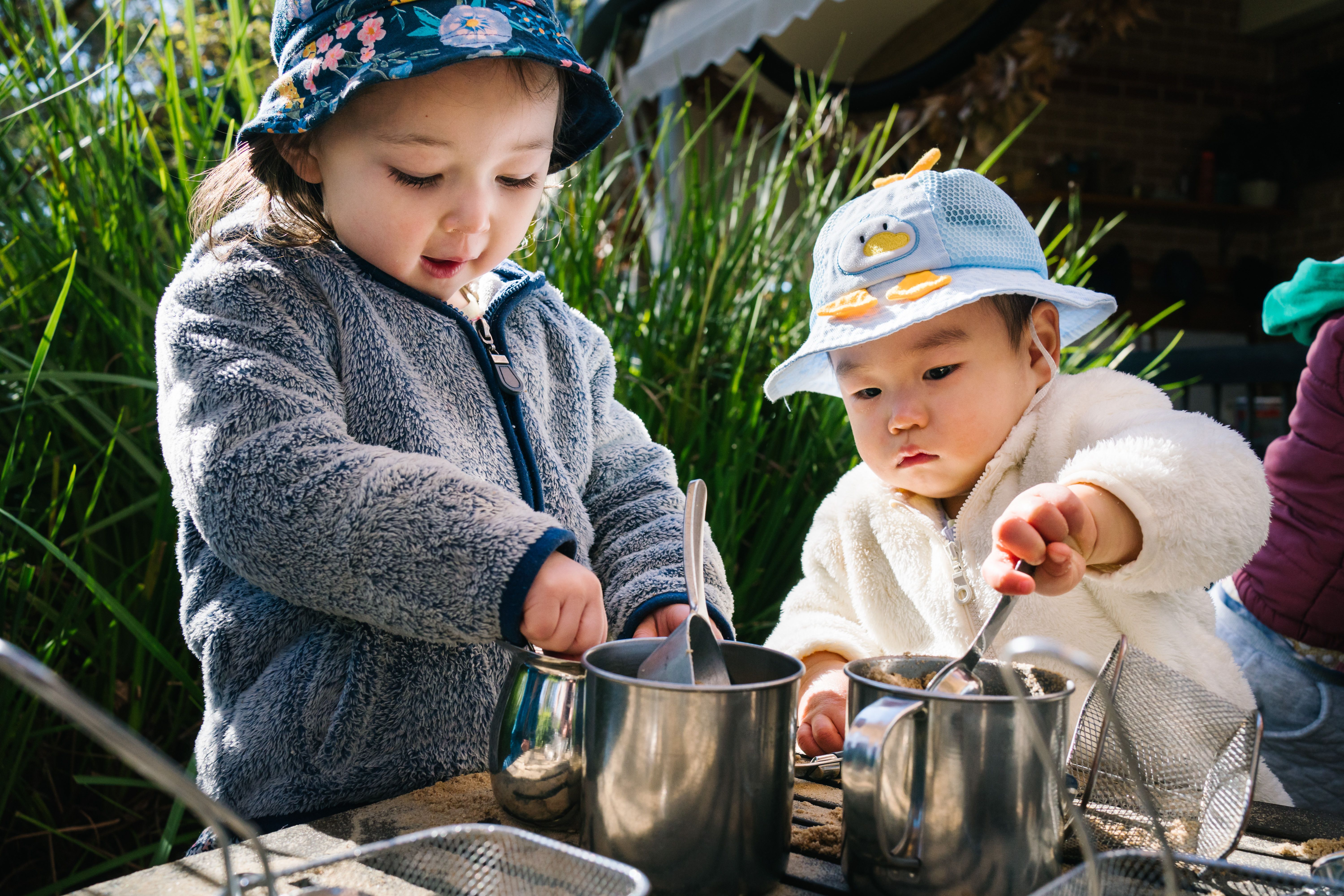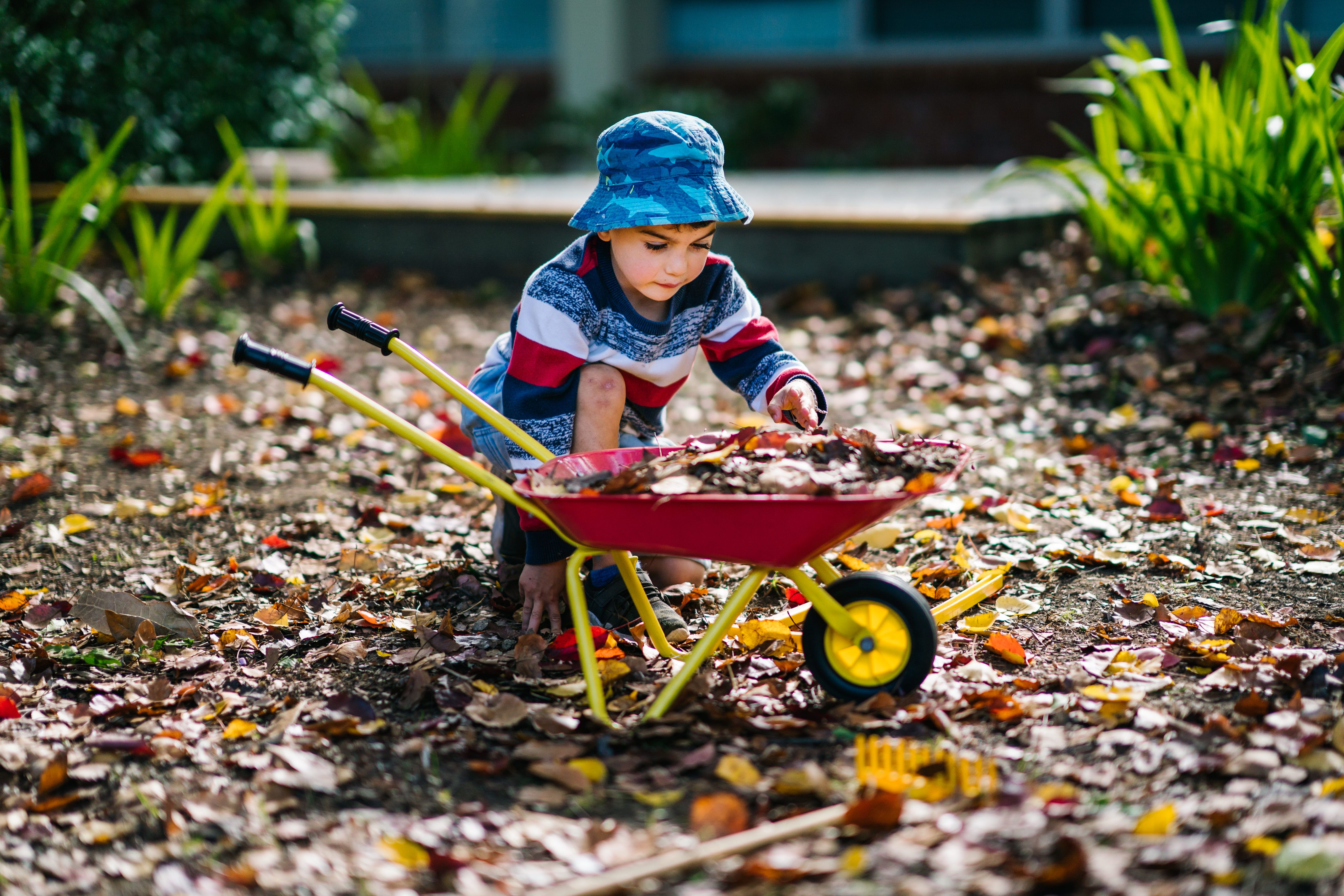[Last updated: 23 August 2025]

Playing outdoors gives your child opportunities to learn as they explore, experiment, create and express themselves.
Children learn in social settings, particularly through play-based learning, by engaging in various planned and unplanned experiences.
When children play outdoors their agency, problem solving, curiosity and creativity grow.
Benefits of outdoor play
Outdoor play has many benefits. When children play together they create social groups, test out ideas, challenge each other’s thinking and build new understandings.
- Physical activity – your child might be more physically active in the extra free space available, particularly if you don’t have much access to outdoor space at home
- Appreciation of nature – many parents notice their child is more interested in nature after playing outdoors (for example watching seasons change or spotting an insect on a leaf)
- Social skills – you might see more children playing together, and notice your child collaborating and negotiating with others
- Respect and equity – you may see less gender-stereotyped play
- Curiosity – playing outdoors grows your child’s curiosity, which is an important foundation for learning
- Problem-solving – playing, experimenting and exploring outdoors helps your child develop problem solving skills
- Active learning – children are actively learning when they are exploring and experimenting outdoors
- Creativity – exploring plants, trees, edible gardens, and using sand, rocks, mud and water in the natural environment develops your child’s creativity.
Why is risk-taking important?
Risk-taking helps your child learn.
Playing outdoors gives your child learning opportunities, including the opportunity to assess and managing risk and build their understanding of safety. Exploring potential risks in the environment, under the supervision of adults in safely controlled spaces, provides opportunities for children to:
- further build their physical capabilities, such as climbing trees, jumping, balancing and sliding
- accept and embrace challenges
- experience feelings of success, pride and exhilaration
- practice and improve their movement skills and spatial awareness.
Outdoor play in children’s education and care services
As part of your child’s daily routine, services will often dedicate blocks of time to outdoor, risky and messy play experiences.
Active and quiet play experiences are offered in natural environments and outdoor spaces.
A range of equipment, resources and open spaces are used to engage children in physical play.
Outdoor environments in services should be:
- dynamic and flexible, providing opportunities for children to be active, and for unique play and learning
- inclusive, to support the diverse needs, interests, preferences and learning styles of all children
- furnished and equipped with materials that allow for multiple uses, encouraging children to become flexible thinkers and investigators.
Educators explain the benefits of outdoor play
'We have seen so many benefits for our children through our outdoor play philosophy. Physically our children become fit, strong, healthy and highly coordinated. Emotionally, we see them develop higher resilience, wellbeing and a greater ability to self-regulate. Socially, we see them working cooperatively and showing respect and being more empathetic to their peers. The outdoors gives us opportunities to have meaningful conversations about things that the children are experiencing, feeling and seeing.'
Outdoor play during cold and wet weather
Outdoor play is encouraged in all seasons, including during cold weather, to give children opportunities to engage in nature based and active play experiences.
Being outdoors during winter when illness is more prevalent is a strategy to minimise the risk of cross infection (for example the spread of cold and flu viruses), particularly when ventilation indoors is limited.
You can help your child engage in outdoor play by ensuring they are dressed appropriately for all weather conditions, and have spare warm clothing, gumboots, raincoats, etc. Your service may also provide suitable clothing as part of their resources. It’s important to have conversations with your child's educators to understand how and when they will be supported to engage in outdoor play year-round.
Tip: Dressing your child for outdoor play in cold and wet weather
A raincoat/padded coat or puddle suit, gumboots, warm hat, gloves and a change of clothes that can ‘get dirty’ will keep your child warm and dry.

In-nature programs in children’s education and care services
An in-nature program can be provided within any education and care service type, including long day care, preschool/kindergarten, out of school hours care and family day care.
It includes children and educators spending time outside the service, with a focus on nature. It is often called Bush kindy/kinder, beach kinder or nature play in Australian children’s education and care services.
If your service has an in-nature program, it will reflect the unique environmental context of your service, the children, families and your community. These programs have great potential to introduce local Aboriginal and Torres Strait Islander ways of engaging with Country, knowing and being for children, families, educators and teachers.
Education and care services must comply with various regulatory requirements when taking children out of the service for in-nature programs. Visit the ACECQA website to learn more about the requirements for in-nature programs.
Outdoor play ideas at home
Outdoor play spaces offer a vast array of possibilities for physical activity and learning experiences.
Play spaces in natural environments may include plants, trees, edible gardens, open spaces, sand, rocks, mud, water and other elements from nature. These spaces invite open-ended play and interactions, physically active play and games, spontaneity, risk-taking, exploration, discovery and connection with nature.
Outdoor play ideas:
- visit your local park or bush area
- set up a blanket outdoors for your infant to play and lay on, pointing out all the elements of nature you can see – the leaves, grass, wind, clouds and sky
- build backyard cubby houses with available resources (such as sheets)
- use discarded kitchen pots, spoons and pans to make mud pies
- walk or cycle to your local park or early education and care service
- create and maintain a vegetable garden or participate in your local community garden.
Learn more about The importance of play in children's learning and development
Chancellor, B, and Elliott, S. (2014) From Forest Preschool to Bush Kinder, in Australasian Journal of Early Childhood, Volume 39, No. 4 December 2014.